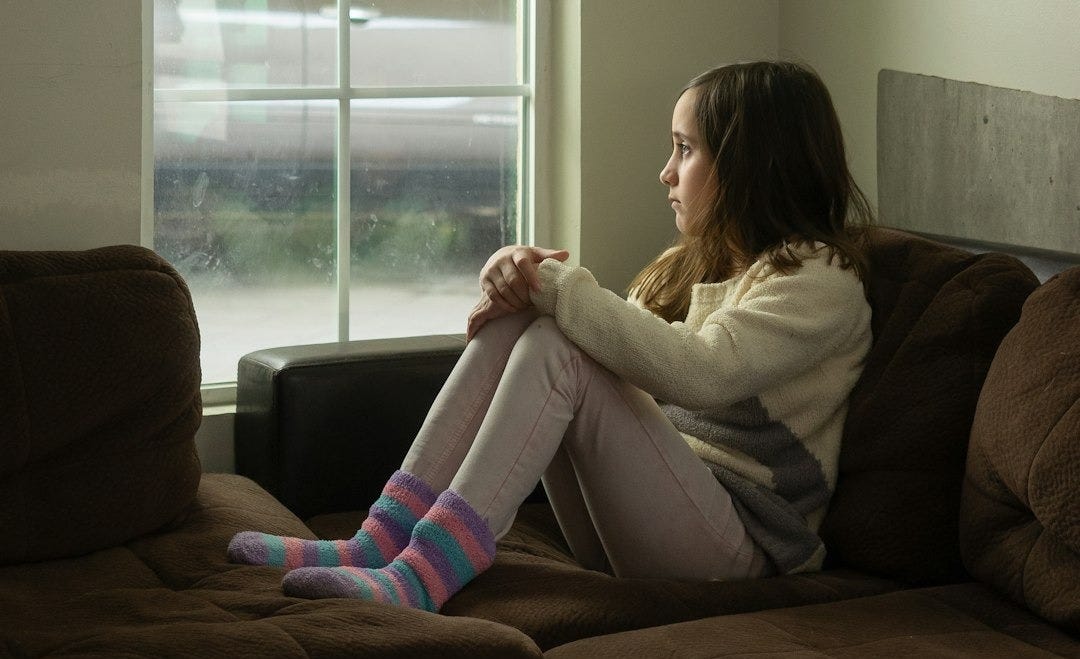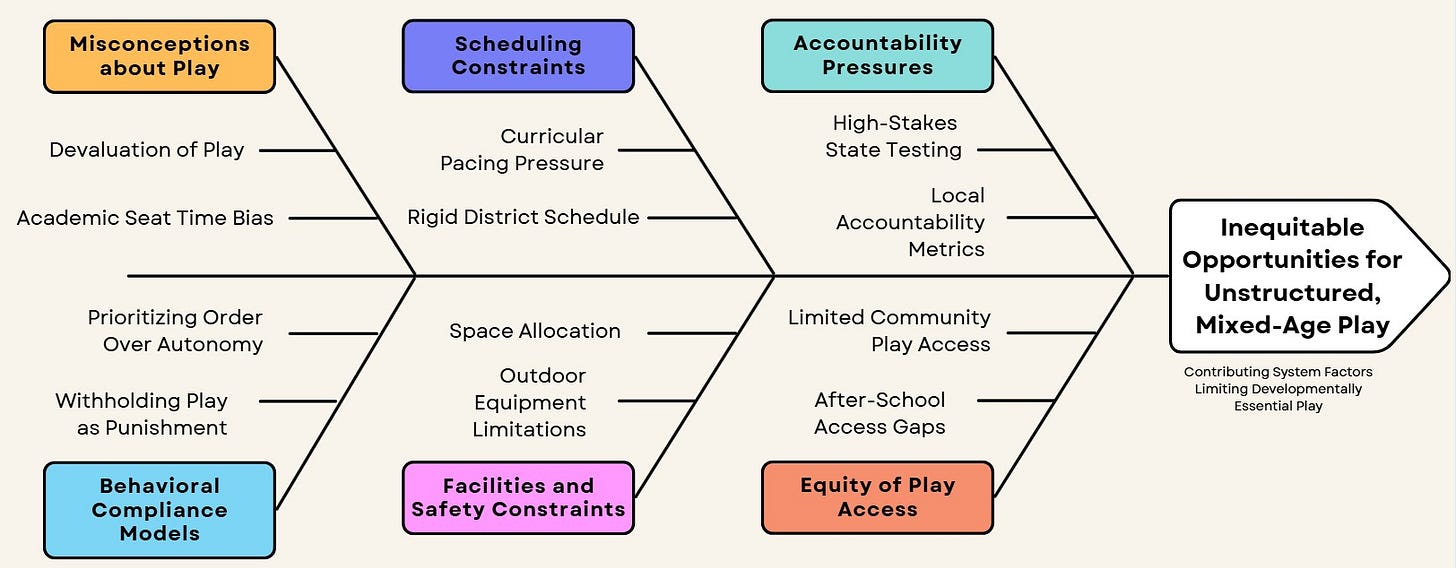How We Designed the Play Deficit That's Killing Childhood
The system isn’t broken. It’s functioning exactly as designed...and starving kids of the developmental opportunities they need to thrive.
We didn’t kill childhood. We professionally managed it out of existence. We bubble-wrapped kids. We traded scraped knees for supervised enrichment. Forts for safe spaces. Resilience for compliance. In the name of protection, we sterilized growth.
Now we’re staring at the consequences: kids who can follow instructions but struggle to live unscripted lives. They reach adolescence having barely faced conflict, solved problems independently, or dared to climb too high. And we wonder why anxiety is skyrocketing.
You don’t build strong humans by removing every struggle. You build them by letting kids fall, argue, fail, and figure it out - early, often, and freely.
But here’s the harder truth: the hollowing-out of childhood didn’t happen by accident. And it didn’t happen because our system is fragile. It happened because the educational system we built is solid and hyperfunctional at producing safety, control, compliance, and standardized testing efficiency. It just wasn’t designed to produce strong, resilient, self-regulating humans.
If we want to fix it, we need to name exactly how we engineered this.
The Six Causes of Developmental Starvation
“Every system is perfectly designed to get the results it gets.” - W. Edwards Deming
This quote is the driving thought behind much of the EdD work I do at Clemson University. How do we redesign the educational system to get better outcomes for all students (because underneath the fragile students, rising anxiety, and dysregulated classrooms sits a structure we built - piece by piece)? We didn’t lose play. We designed its disappearance through six intersecting pressures.
1. Misconceptions About Play
At the foundation sits the myth that play is extracurricular. Optional. A bonus for after the “real work” is done.
We still carry an industrial-era mindset: more instruction equals more learning. Play feels inefficient, unmeasurable, frivolous. So we cut recess when scores slip. We withhold playtime for misbehavior. We schedule it last, shrink it, supervise it, sanitize it.
And yet every developmental scientist agrees: play isn’t a break from learning. It’s the delivery system for learning.
Play is where kids practice conflict resolution, emotional regulation, risk assessment, negotiation, creativity, independence, and peer connection. When we sideline play, we eliminate the very experiences that build strong, resilient, capable humans.
2. Scheduling Constraints
The school schedule doesn’t bend. It locks.
Bells ring. Pacing guides dictate weekly content. Remediation blocks, intervention pull-outs, test prep, all stack on top of each other until there’s no space left to breathe.
The natural rhythms of childhood (meandering, exploring, communicating with peers) get squeezed out entirely. There’s no “extra time.” The machine was designed that way.
We built efficiency.
We lost humanity.

3. Accountability Pressures
The accountability engine warps every decision downstream.
High-stakes testing doesn’t just measure outcomes. It dictates priorities. Test scores determine reputations, leadership evaluations, state report cards, and political survival.
Unstructured play (and the crucial life skills and characteristics kids learn while playing)? That doesn’t register on any metric that matters to any outside entity.
So schools chase seat time, compliance, and measurable outputs. Teachers feel trapped, defaulting to worksheets, scripted lessons, math apps, and rigid management. Every moment becomes another opportunity to cover more content rather than develop well-rounded, healthy, and well-adjusted people.
The system produces exactly what it was designed to: test data.
Resilient humans? That’s collateral damage.

4. Behavioral Compliance Models
Here’s what no one wants to admit: many “behavior problems” are developmental gaps caused by lack of play. We pathologize what kids are wired to do, move, explore, negotiate, argue, fail, and recalibrate, because it disrupts our controlled classrooms. So we tighten discipline systems, reward silent compliance, and double down on managing every interaction.
And the cruelest irony? We punish dysregulated kids by removing recess, taking away the very developmental tool that would help them build regulation in the first place.
We don’t have a behavior problem.
We have a play deprivation problem.
5. Facilities and Safety Constraints
Even when schools want to offer more play, physical and legal barriers pile up. Urban schools lack green space. Rural schools lack equipment. Insurance policies discourage climbing structures and risk. Liability fears shut down adventurous play.
So we flatten playgrounds into plastic safety zones. We design for litigation, not for child development.
We aren’t short on playgrounds. We’re short on risk, mess, and unsupervised invention - the very ingredients that build confidence and resilience.

6. Equity of Play Access
And perhaps most invisibly: not every child loses play equally.
Affluent families can reclaim some playtime through private yards and backyard playgrounds, memberships to local recreation centers and gyms, enrichment camps, and access to private tennis courts, swimming pools, and basketball courts.
But for many kids, especially in marginalized communities, school is the only safe place for peer interaction, physical play, and social learning.
When schools shrink or eliminate recess, these kids don’t make it up at home. They lose it completely. And that loss quietly accelerates inequality, depriving the students who most need resilience-building experiences of their only shot at getting them.
The System Is Solid. The Outcomes Are Fragile.
Zoom out far enough, and you see the real problem.
The system isn’t broken.
The system is working exactly as designed.
Stable. Efficient. Highly controlled.
It produces safety, packed schedules, test prep, behavior charts, and compliant classrooms. But it was never designed to produce healthy humans who can handle life in the modern world.
We didn’t purposely create fragile kids, but we did create a system that leaves no room for growing strong.

Schools as Developmental Ecologies
But here’s the good news: we can always build something better.
Schools are developmental ecologies, living systems where kids either thrive or wither depending on the experiences we design into the day. We don’t need a revolution. We need small systemic shifts that rewild childhood inside the school day.
We can:
Protect recess like sacred instructional time.
Create Play Clubs where mixed-age kids practice life’s most important skills.
Build forest classrooms and loose-parts playgrounds that invite invention, risk, and movement.
Design schedules with actual breathing room.
Train teachers to see conflicts as developmental work, not behavioral failure.
Demand accountability models that value whole-child development, not just test scores.
Invest in facilities that guarantee play access in every neighborhood.
Center equity not just in academics, but in developmental opportunity.
Because this isn’t enrichment.
This is the work.
Play is learning.
The Choice
We stand at a fork in the road.
One path leads to more management, more control, more compliance…and more fragile kids.
The other leads back to what every child development expert, evolutionary biologist, and grandparent already knows: kids need room to breathe, space to try, permission to fail, and freedom to play.
We’ve hollowed out childhood long enough.
It’s time to rebuild.
The architecture matters.
The work starts now.





Thanks for laying out your argument like this @kevin. Very helpful.
The system is essentially putting out any spark of creativity in children. When kids are given enough time and freedom to play, to find their way to creativity (not the adult-designed version of it) they win. And everybody else wins. And then all those skills we try to "teach" them come out organically-perseverance, problem solving and even entrepreneurial spark.